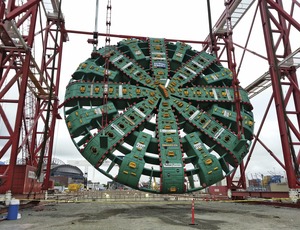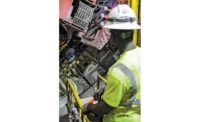
Lowering a 7,000-ton tunnel-boring machine piece by piece into an 80-ft-deep launch pit sloped 3° forced Barnhart Crane and Rigging to think outside the boom. The subcontractor working at the Alaskan Way Viaduct in Seattle opted to use a modular lift tower instead of a conventional crawler crane, saving millions of dollars and valuable site space.
The largest tunneling machine built for North America, Bertha—a 57.5-ft-dia unit—will this summer bore a 1.7-mile-long tunnel to replace the aging Alaskan Way Viaduct. Barnhart performed intricate engineering under its $6-million contract to deliver the TBM, says Matt Brennan, vice president of branch operations for the Memphis-based company.
"Our lift tower is a specifically designed modular system, so the lifting is done right at the pit, and the loads are transferred down on the rails into the foundation," Brennan says. "And the lift tower only occupies the space where the component is located over the pit."
The scope of Barnhart's work included receiving the 41 TBM pieces—built by Hitachi Zosen Corp. in Osaka, Japan— from a jumbo freighter in the Port of Seattle in April. It then hauled each piece—the largest weighing 932 tons—500 yards across the port property to the staging area, where it is still maneuvering the pieces into the pit with precision.
At the port, crews couldn't disrupt container-loading activity during nine days of hauling, so they sequenced loads to meet the dock's loading limits. Barnhart dispatched a fleet of Goldhofer self-propelled modular transporters, the largest of which was a 24-axle by eight-file unit measuring nearly 43 ft wide and 120 ft long, plus an additional 14 ft of hydraulic drive units at one end. The trailer had 768 tires on the ground.
The unloading and transporting "was a monumental achievement," says Chris Dixon, project manager for Alaskan Way's design-builder Seattle Tunnel Partners, a joint venture of Dragados USA and Tutor Perini Corp. "Most importantly, it was performed efficiently and safely without any injuries, damages or incidents."
While logistics proved key in the haul, engineering took center stage for the lifts. Conventional methods would call for a gigantic crawler requiring massive ground space and bearing capacity. Further, the rigging would require a monster boom, squeezing out other staging activities and potentially setting the project behind schedule. By using the lift tower, which operates in a similar way to an overhead gantry crane, Barnhart saved the project millions of dollars by not setting up a crawler crane, Brennan says.
"Our modular tower comes in with permitted, standard truck loads and gets put together like Legos, without requiring counterweights," he says. "The lower- profile system makes the job work."
The height of the tower, which uses a six-leg design and moves along a slide system, is about 125 ft to the top of the strand jacks. The slide track runs along the launch-pit walls, with additional strand jacks atop the tower so crews can translate TBM components laterally. Overall, the tower features four strand jacks that range between 720 and 940 tons in capacity. To assist on-site, Barnhart also has a Demag CC 1800-1 crawler crane as well as a Link-Belt RTC-80110 Series II rough-terrain model.
With 41 picks, each piece required exacting lift plans, all within the proper sequencing for reassembly of the TBM. The rigging was designed to accommodate the differing lifting points and elevations of each piece. Barnhart modeled all the lifts—the largest was 1,250 tons—before hoisting. The 745-ton cutterhead was lowered into the pit on May 31.
The rigging crew will remain on-site through June with a 360-ton crawler crane for support. "It was a pretty tremendous engineering effort for us," Brennan says. "Just in the rigging designs we have thousands of engineering hours."





Post a comment to this article
Report Abusive Comment